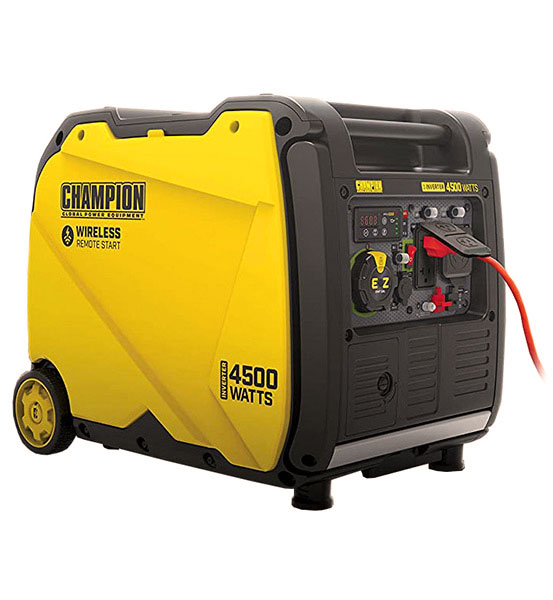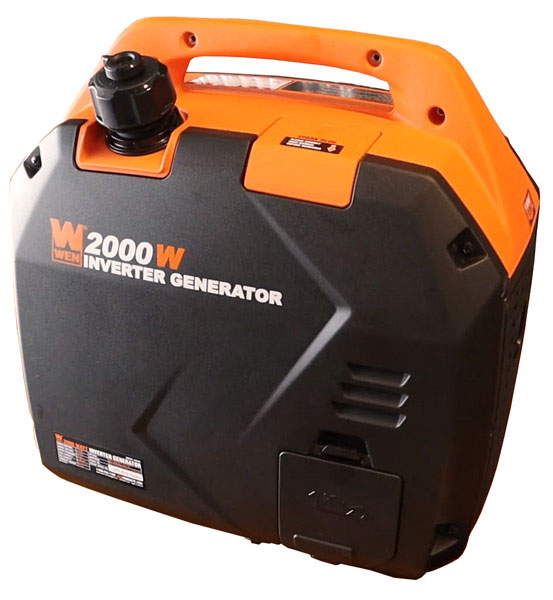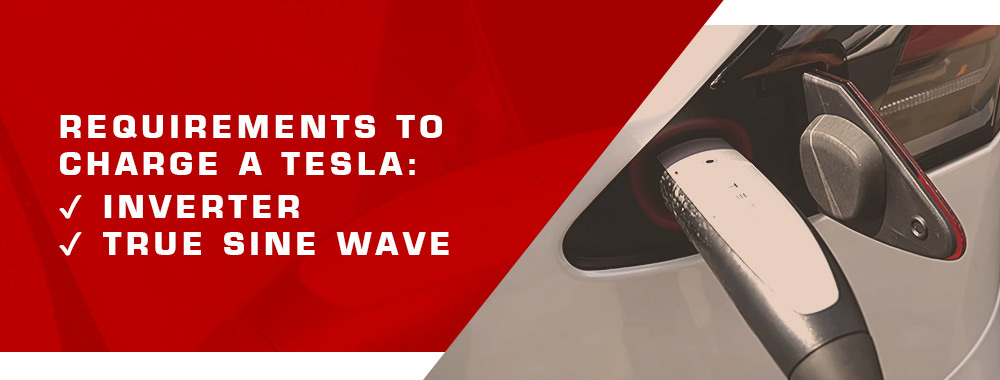As an EV enthusiast, there are only a few things that can really make or break your day. Electricity is one of these. The ability to access energy when you need it is essential for powering your Tesla effectively and efficiently.
A common scenario: with the arrival of a storm, the power goes out. The nearest available Level 2 charging station that hasn’t been knocked out is a dozen miles away. When you get there, you see a line of cars and realize you’ve wasted your battery getting there. In emergency situations, dinner can be heated on a gas burner, but a horse-drawn Tesla is out of the question today.
In fact, there can be many scenarios when you need to charge an EV from a generator, from a plan to visit a remote campsite to emergency situations. Charging the Tesla with a generator is only available for certain models, which you can read about below.

A portable generator is a great option for those who need portable power that they can count on. But it’s important to know that not all generators are capable of charging your Tesla.
The good news? You don’t have to be an expert to get the most out of this truly amazing piece of equipment. Here’s what you need to know about charging the Tesla from a generator.
Comparison of Tesla and EV portable generators
| Image | Product | |
|---|---|---|
Best Choice  | Generac G0071540 GP3300i — Best Choice with the overall best performance
| Check Price READ OUR REVIEW |
Also Great  | Generac GP2500i Inverter
| Check Price READ OUR REVIEW |
Also Great  | Honda 663520 EU2200i 2,200 Watt
| Check Price READ OUR REVIEW |
Also Great  | Champion Power Equipment 200986 4,500 Watt
| Check Price READ OUR REVIEW |
Also Great  | WEN 56203i Super Quiet 2,000 Watt
| Check Price READ OUR REVIEW |
Specs comparison of the generators
| Generac G0071540 GP3300i | Generac GP2500i Inverter | Honda 663520 EU2200i | Champion Power Equipment | WEN 56203i | |
|---|---|---|---|---|---|
| Output starting/running | 2.5—3.3 kW | 2.2—2.5 kW | 1.8—2.2 kW | 3.5—4.5 kW | 1.7—2.0 kW |
| Weight | 59.5 lbs | 48 lbs | 53.57 lbs | 95.7 lbs | 39 lbs |
| Tank volume | 1.06 gallon | 1.0 gallon | 0.95 gallon | 1.6 gallon | 1.0 gallon |
| NEMA Outlets | L5-20 5-20R Duplex |
5-20R Duplex | 5-20R Duplex | TT-30R 5-20R Duplex |
5-20R Duplex |
| Time to charge a Tesla Model 3 from 20 to 80% | 15+ hrs | 15+ hrs | 18+ hrs | 9+ hrs | 19+ hrs |
As a Tesla or other EV brand owner, you might find yourself in situations where you can’t connect to the grid to charge your vehicle. This may happen on camping trips or during power outages caused by natural disasters. A portable gas-powered generator can save the day and give you enough charge to get home or to the next EV charger. If you are planning to get one, this review will help you select the most reliable gas generator for a Tesla. Jump to the comparison chart.
So what kinds of generators can you find on the market? And which will work for your EV?
Not all generators are capable of charging your electric car.
1 Portable generators — It’s not for charging a Tesla
The charging cycle is the most basic way to charge a generator. It is an AC motor that powers an electrical device.
2 Battery Charger / Converter — It’s not for charging a Tesla
Charging by battery is the quietest, cheapest but slowest way to charge. It can be used with a solar power system for off-grid living. It’s not good for EV charging.
3 Standby Generators or Specialty Generators — It’s not easy
There is charging support for large power requirements, such as charging a gas turbine generator. There are charging sources that can do this. Some charging generators can be adapted to work with alternative fuel sources. You’re not going to find one of these in your neighbor’s garage.
4 Inverter — It’ll charge your Tesla or an EV, but…
The charging source that’s used in most modern portable generators today, inverter charging is also the most efficient charging method. Inverters can be used to convert a charging cycle generator or an AC power outlet into a charging station for your battery bank or deep-cycle battery needs. The problem with inverter charging generators is they’re usually the most expensive charging options, and they’re also the noisiest charging sources…
What specs should a generator have in order to charge a Tesla?
True Sine Wave (TSW) — is an important factor in the generator needed to charge the Tesla.
A true sine wave is a smooth waveform of electrical output. An alternating current that is made by a TSW inverter, like the best choice of inverter, has this kind of waveform. A modified or square sine wave inverter does not have this kind of waveform.
All EV charging stations should be powered by TSW sources. Jump to the comparison chart.

If you don’t want to deal with sine waves, you will only see tried & true Tesla-friendly generator models in this review.
What is important to us when choosing a Tesla gas generator?
When comparing the two options, keep in mind the following four criteria:
- Maximum Power
- Outlet Type
- Fuel Consumption and Running Time
- Noise Levels
- Parallel Operation
- Warranty
- Specs
We selected 5 tested models according to these parameters basedon our customers’ experience. More about that further on. Jump to the comparison chart.
Common outlet types of generators

In non-inverter generators the variety of sockets is wider (there you can find L5-30 and L14-30), but they’re not what we want. Tesla gas generators, suitable for us, most often have the NEMA socket 5-20 (compatible with the usual plug-in 5-15). Less common are L5-20 and TT-30.
NEMA 5-20s are rated up to 20 amps, 120 volts, and 2,400 (1,920) watts. They will power your Tesla for a couple of miles, which means they can be a reliable power source if you need to get to the nearest power station. However, these outlets are not suitable if you need a power source that lasts a few days.
Tesla vehicles come with special sockets. They are compatible with NEMA outlets thanks to Mobile Connectors. Older Tesla models had 14-50 and 5-15 connections, while newer cars are limited to Gen 2 and NEMA 5-15 outlets (it’s compatible with NЕMA 5-20).
All of the portable generators to charge Teslas in this review have a 5-20 socket, and some of them have other additional sockets.
Charging speed forecast
How long will the Tesla Model 3 run after one hour of charging from a particular socket? This is shown by the mph parameter.
| mph | 20%→80% battery | |
| Nema 5-20 | 10 | 15+ h |
| Nema L5-20 | 10 | 15+ h |
| Nema TT-30 | 17 | 9+ h |
How long does it take to charge a Tesla from a generator? To charge the battery to 60%, you will have to use the recommended generator for at least 15 hours. Other calculations can be done with this charge time calculator. Below is a detailed table of the different generators for charging a Tesla or EV, considering also the charging speed.
Limit inbound power for proper charging
Start charging by setting a limit on the consumption of your electric car. This is done in the interface. Start with the minimum values, then increase to 20A (or more depending on the portable generator model) within a few minutes.

Product #1. Generac G0071540 GP3300i — Best choice with the overall best performance
The Generac G00 inverter generator is compact and very portable. It uses Quiet Inverter Power technology to reduce noise during operation and to provide optimal performance.
There is the economy mode that helps to conserve fuel by automatically adjusting the engine speed, which also reduces the noise produced.
The Generac is lightweight at 59.4 pounds, allowing it to be carried around easily by its handle. Apart from charging an electric car, it can also juice up mobile devices like smartphones and tablets through its USB ports. The status lights warn when something is wrong, for instance, the oil level is low or there is an overload on the generator.
Performance
The Generac is rated for 3,300 watts starting and 2,500 watts running, and provides clean and stable power suitable for charging an electric car. However, changing the oil is a chore, as the large side panel has to be removed with a screwdriver first.
Recommended?
This is the best choice as it balances performance, price, and weight very well.







Product #2. Generac GP2500i Inverter — Great features but with lower output
It has a bright orange and black plastic exterior. It has a simple startup procedure. It has a simple startup procedure.
The generator weighs 48 pounds and has a built-in handle. It does not take up much space.
This generator also has an economy mode for saving on fuel and LED indicators for when it needs attention or other statuses like low oil level or that the generator is ready to charge the car.
The Generac GP2500i Inverter has a safety feature that shuts down the engine automatically when the oil is too low to prevent damage. The outlets are covered for protection from the environment. The fully enclosed design of the generator reduces the amount of noise produced during operation.
The Generac GP2500i can connect in parallel with another Generac GP2500i to output more power.
Performance
The Generac is rated for 2500 watts starting and 2200 watts. The process of changing the oil is, however, needlessly complicated.
Recommended?
This generator has many practical features and good enough power output. It is easily recommended.








Product #3. Honda 663520 EU2200i 2,200-Watt — Generator with CO-Detection and Smartphone app
It has a bold red and black appearance. The Honda 663520 works on quietly that you can’t hear it over a normal conversation. It is also fuel-efficient, lasting up to 8 hours on 0.95 gallons of fuel.
It weighs only 53.57 pounds and comes with a built-in handle. It has a feature called CO detector that monitors the level of carbon monoxide and shuts down when the level is dangerously high. There are also indicator lights for oil alert, overload alarm, and eco throttle to ensure the generator works optimally.
Performance
The maximum power output of the Honda 663520 EU2200i is 2,200 Watts, and 1,800 Watts loaded. It is easy to disassemble for maintenance. It can be turned off via Bluetooth and monitored with a smartphone app that offers oil change reminders.
Recommended?
With the rated output so low, it will take longer to charge up your car battery. However, the three-year warranty offered by the manufacturer increases confidence in the product.








Product #4. Champion Power Equipment 200986 4,500 Watt — Most powerful but heavy and costly
The main difference from other models is the presence of an additional TT-30R socket. This is a popular socket among RV adepts, and it will help you get more power from the 30A socket for the Level 2 charger. It is easy to use with the NEMA 14-50 adapter to connect the Tesla Mobile Connector.
The Champion generator is very efficient, as it can run for up to 14 hours on only 2.3 gallons of fuel. The total weight is 95.7 pounds.
There is an intelligauge feature on the control panel for monitoring the voltage, frequency, and hours of operation, while the economy mode will monitor fuel consumption in real time.
There are two wheels at one end of the generator for easy movement. It also has cold-start technology that allows it to start quickly during cold weather.
Champion Power is offering a three-year warranty with free lifetime technical support.
Performance
The Champion Power generator has rated capacity of 4,500 Watts starting rating and 3,500 Watts loaded. More power can be gotten by combining two generators using the optional parallel kit. However, its heavy weight renders it less portable than the rest of the generators on the list.
The Champion Power will charge your electric vehicle faster but the high price and heavy weight make it hard to recommend.







Product #5. WEN 56203i Super Quiet 2,000 Watt — Ultra lightweight but less powerful
The WEN 56203i is just 39 pounds, making it easy to transport or lift with its built-in handle. It produces low sound when in operation.
The generator uses up all the fuel in the carburetor before shutting down, which prevents damages to it. There is also an eco-mode feature that automatically adjusts fuel consumption to save on fuel costs.
There is a two-year warranty from the manufacturer covering the generator.
Performance
The WEN generator produces 2,200 Watts starting rating and 1,700 Watts loaded, which means it will take the longest to charge your electric vehicle. However, you can link up two WEN generators in parallel to increase the power output, with the help of the Parallel Connection Kit that is sold separately.
The WEN generator is the least recommended despite its lightweight because it will take so long to charge your electric vehicle. However, it can work in a pinch.




What did we look at when selecting the best generator models for Tesla?
In addition to power, charging time of the Tesla from a generator and technical specifications, we consider other factors.
#1 — Fuel Consumption and Running Time
The most efficient charging sources available today, inverters consume about 8 % of their overall power output charging your Tesla battery via a charger. The least efficient charging sources available today, charging cycle generators consume about 20% of their overall power output charging batteries. That’s why we focus on efficient inverter generators when choosing.
#2 — Noise Levels
Yes, true sine wave generators can be noisier than others. However, the noise level is determined by the design feature and the power limit.
#3 — Charging Costs
If you want to charge off your generator as much as possible, inverter charging generators are the most cost effective charging sources available today. Since a portable generator is often considered in the sense of a temporary solution, such use will not significantly harm your budget. The fuel consumption is proportional to the allowable peak power of the generator.
#4 — Parallel Operation
Some portable generators for Tesla allow you to connect multiple devices because they have several outlets. Obviously, the power when plugging in another device will reduce the power capabilities of your electric vehicle charging station.
#5 — Warranty
Warranties range from 90 days up to 5 years on portable charging generators. Inverter charging generators have shorter warranties than charging cycle charging generators because their AC to DC charging inverters tend to wear out over time. If you’re charging your battery bank or charging station very little during an emergency situation it’s not a problem.
FAQ
How do I charge my Tesla with a portable generator?
Yes, you can charge your Tesla with some generators. You will need a properly grounded inverter that produces a clean sine wave. You will also need a high power generator. A minimum of 2,000 watts is recommended when trying to charge your Tesla with a generator.
What power settings should I set in the Tesla when charging from a portable generator?
The alternator needs time to warm up. Accordingly, set the amperage to minimum with the dashboard monitor. Don’t add amps too quickly, or you risk damaging the alternator. Instead, slowly work your way up to 20–30 amps and then up to the alternator’s maximum output.
Can I use a generator to regularly charge my Tesla?
It is impractical and certainly not recommended to do so. You should not rely on a generator even as a backup plan to charge your electric vehicle. Using a generator makes the entire process of driving a Tesla less environmentally friendly than driving a conventional gasoline-powered car.
Vehicles that run on gasoline convert it directly into kinetic energy, which is not the case with power generators. Specifically, a generator first uses gasoline to produce kinetic energy and convert it into electricity, which charges your Tesla. This energy is then converted back into kinetic energy as you drive your electric car. This is a very inefficient process of turning fuel into kinetic energy that moves your car.
The idea of combining an alternator and batteries in cars to increase the driving distance has existed for a long time. But since then, batteries have been improved, and there is no longer such a need for them to be supported by an alternator.
Is it possible to connect a Level-2 EV charger to a portable generator?
Depending on the power of the portable generator, it will support L1 and/or L2 devices. In our comparison you will find generators that support high power connection over the TT-30R socket, which will be suitable for the Level-2 charging.
Since I will use the generator only occasionally, do I need to do maintenance on it?
Yes, maintenance is necessary so that you can use it when you need to do so. If left abandoned until there is an emergency, the generator might have problems starting. Be sure to run the generator once a quarter to make sure it is working well. Check the oil level regularly. Keep a maintenance schedule. Many generators will strain their coils when they run to the last drop of oil. If you need to store the generator for some time, add a stabilizer to the fuel in the tank or drain the remaining fuel. Keep the generator protected from rain or moisture.
Can I connect the Tesla Mobile Connector to a gasoline generator for charging?
Tesla vehicles may be charged using a pure sine wave inverter and a grounding solution, as long as the generator is an inverter that provides a pure sine wave and has some sort of grounding solution.
Can I charge my vehicle on the road?
You should never charge your electric vehicle while you drive, as it is not safe. You would be breaching the warranty of a Tesla car, as the manufacturer explicitly warns against doing so. Further, it’s simply not possible to charge your EV while in motion, at least not without significant alterations to your EV — which would void your warranty and possible cause serious damage.
How long can a generator run continuously on one tank of gasoline?
Based on the manufacturers’ instructions, with 50% of the load connected, we can expect the portable generators reviewed here to give us about 9–10 hours of continuous and stable power supply on a full tank. But when charging an electric car, the load is usually higher and this reduces the continuous power supply to 5 hours on one tank.
Can I parallel two generators to charge my electric car?
Yes, you can, if specified by the manufacturer. However, make sure you follow the generator manufacturer’s instructions. For example, Generac states you can only parallel two generators of the same model.
Is it possible to charge an electric car with a power extension cord?
When charging your electric car, don’t use a household multi-socket extension lead. Go with a reputable seller or the manufacturer when purchasing a charging cable that follows US safety standards. Use these basic recommendations for EV drivers and read more about comparison items here.
How much power for a generator do I need to charge a Tesla?
You’ll need a generator with at least 1,500 watts, otherwise you’ll be far from being able to charge the electric car. It would be more ideal if you have a 3,000 watt generator with a true sine wave and an EV determines that it is properly grounded.
I’ve heard of cases where the Tesla didn’t take a charge from the generator, why?
The alternator for your Tesla should produce an unchanged pure sine wave. All Tesla’s come with built-in protection that prevents charging from unstable power sources. Charging with an alternator that outputs anything other than a pure sine wave can cause a destructive voltage spike and damage your vehicle.
Here we have selected sine wave generator that charge electric cars and that include Teslas.
Which generators can I use to charge my electric vehicle?
When selecting a generator that you will use to charge your car, make sure it is the type that produces a clean sine wave. Tesla, for example, detects when the sine wave is dirty and simply won’t charge. The generators above produce a clean sine wave.
How do I prepare to charge my car with a generator?
It is important to ensure the generator is grounded properly. Again, a Tesla won’t charge if the grounding is not done properly. Many generators use the frame for grounding. This info can be found in the owner’s manual of each model. Always start charging with a low charge rate and gradually adjust to about 20–30 amps.
Our Top Pick
While it is not recommended to charge an electric vehicle with generators frequently, emergencies do happen that leave little or no choice. It is important to select the best generator and keep it well-maintained so that it does not disappoint you nor damage the car.
While the Generac G0071540 GP3300i Portable Inverter Generator is our best choice, any of the generators above will get the job done. They are trusted, as they have great buyers’ reviews.
Contents
- 1 Comparison of Tesla and EV portable generators
- 2 Specs comparison of the generators
- 3 So what kinds of generators can you find on the market? And which will work for your EV?
- 4 What specs should a generator have in order to charge a Tesla?
- 5 What is important to us when choosing a Tesla gas generator?
- 6 Common outlet types of generators
- 7 Charging speed forecast
- 8 Limit inbound power for proper charging
- 9 Product #1. Generac G0071540 GP3300i — Best choice with the overall best performance
- 10 Product #2. Generac GP2500i Inverter — Great features but with lower output
- 11 Product #3. Honda 663520 EU2200i 2,200-Watt — Generator with CO-Detection and Smartphone app
- 12 Product #4. Champion Power Equipment 200986 4,500 Watt — Most powerful but heavy and costly
- 13 Product #5. WEN 56203i Super Quiet 2,000 Watt — Ultra lightweight but less powerful
- 14 What did we look at when selecting the best generator models for Tesla?
- 15 FAQ
- 16 Our Top Pick

Hi,
I have a 2018 Tesla X. I am waiting on a trimotor cybertruck ordered over a year ago. I am doing some pre-planning about the type and size of a travel trailer to go along with it. I camped with my Tesla X and a 20 ft Rockwood Geo Pro but could only go about 100 miles round trip w/o recharging. I am thinking about getting a Champion 12,000 Watt inverter generator in case I get caught not near a charging station. My cybertruck is supposed to get 610 miles. I am trying to approximately size a trailer that uses about half of that while towing. It would probably be a 24 – 27 ft trailer. Either 30 amp or 50 amp with 2 air conditioners. So I am trying to realistically have 250 miles of real time travel available. I am not concerned about cost. I would mount the generator in the bed if the truck or at rear of the trailer. Do you think my pick is a generally acceptable solution? Thank you.
A 12kW generator will work for your Tesla. You have a good idea, considering the car’s power limit is 11.5kW (AC). The most popular Champion generator model of 12kW is not an inverter, so be careful with the choice, given this parameter.
I’ve tried charging my Tesla Model 3 with a Honda EU3000iS generator during a power outage. It worked, but the charging speed was definitely slower. It’s a good backup, but not ideal for regular use.
I’ve had a similar experience with my Chevy Bolt and a Yamaha generator. It’s a decent workaround in a pinch, but I wouldn’t rely on it for daily charging.
Has anyone used a solar-powered generator for EV charging? I’m thinking of going green and wondering if it’s a feasible option.
For those trying to charge with a generator: 1. Check your EV’s charging specs. 2. Match it with a generator that exceeds those specs. 3. Use a surge protector. 4. Monitor the process closely. Remember, it’s a temporary solution.
Looking for a cost-effective generator that can handle EV charging. Any suggestions?
I’d recommend the Westinghouse iGen4500. It’s not too pricey and has been reliable for my occasional EV charging needs.
Tried charging my Nissan Leaf with a generic generator and it kept tripping. Anyone else face this and found a workaround?
Sounds like the generator might not be delivering a consistent power output. I had to upgrade to a more robust model to avoid those issues with my Leaf.
Between the Honda EU3000iS and the Yamaha EF3000iSEB, which is better for occasional EV charging?
If you’re using a generator, always ensure it’s in a well-ventilated area. Carbon monoxide is a silent killer. Safety first, folks.
Just read about a new portable generator coming out next month that’s designed specifically for EVs. Keep an eye out!
Anyone in the Denver area interested in a group buy for the Westinghouse iGen4500? Might get a discount if we buy in bulk.
Remember, folks, generators can be noisy and emit fumes. If you’re in a residential area, be mindful of your neighbors and local noise ordinances. Don’t want to get slapped with a fine.